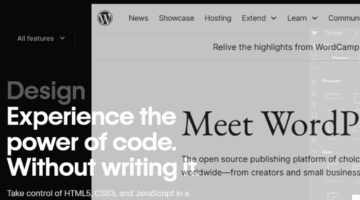Photo by Team TGM
If you’re planning to build a website in 2025, you’ve probably come across two of the most popular platforms: Webflow and WordPress. Both tools are powerful, flexible, and widely used—but they cater to very different types of users.
So, which one is right for you?
In this detailed comparison, we’ll break down the key differences between Webflow and WordPress across important factors like ease of use, pricing, SEO, design flexibility, and more. Whether you’re a beginner, a designer, or a business owner, this guide will help you make an informed decision.
Table of Content:
Quick Comparison Table
|
Feature |
Webflow |
WordPress |
|
Ease of Use |
Visual drag-and-drop builder |
Requires theme setup & plugins |
|
Hosting |
Built-in with SSL & backups |
Needs third-party hosting |
|
Design Control |
Pixel-perfect visual control |
Depends on themes & page builders |
|
Content Management |
Built-in, simple CMS |
Extremely powerful & flexible |
|
SEO Tools |
Built-in SEO settings |
Requires plugins (Yoast, Rank Math) |
|
E-commerce |
Basic built-in features |
Advanced with WooCommerce |
|
Pricing |
$14-39/month (all-inclusive) |
$15-50/month (hosting + add-ons) |
|
Learning Curve |
2-3 weeks for designers |
Varies (beginners to advanced) |
|
Customization |
Limited to platform features |
Unlimited with code access |
|
Community Support |
Small but growing |
Massive global community |
|
Best For |
Designers, agencies, portfolios |
Blogs, e-commerce, content sites |
Ease of Use
Webflow
Webflow is a visual website builder, meaning you can drag and drop elements, style them live, and see real-time changes. It’s perfect for designers who want control without touching code. Beginners may face a slight learning curve, but it’s manageable with Webflow University tutorials.
WordPress
WordPress isn’t a drag-and-drop builder by default. You’ll need a theme and plugins like Elementor or Divi for visual editing. While it offers flexibility, setting it up may be confusing for absolute beginners—especially when configuring hosting, security, or plugin compatibility.
Verdict:
- Go with Webflow for a visual-first experience.
- Choose WordPress if you’re okay managing themes, plugins, and hosting.
Design Flexibility
Webflow’s design capabilities: Webflow gives you pixel-perfect control over every element. You can create custom layouts, animations, and interactions without touching code. It’s essentially a visual designer website builder that outputs clean HTML and CSS.
WordPress design options: WordPress design depends entirely on your theme and page builder combination. Popular builders like Elementor or Divi add visual editing capabilities, but you’re still working within theme constraints.
Customization comparison:
- Webflow: Complete design freedom, but limited by platform features
- WordPress: Theme-dependent design, but unlimited through custom development
Performance impact: Webflow generates clean code making sites faster out of the box, while WordPress sites can be slow due to code bloat without specialist knowledge.
Winner: Webflow for designers who want complete visual control, WordPress for developers who need unlimited customization through code.
Content Management System (CMS)
Webflow CMS
Webflow includes a built-in CMS perfect for blogs, portfolios, or team directories. It’s structured and visual, which is ideal for small to medium websites.
WordPress CMS
WordPress powers over 40% of the internet, and its CMS is one of the most advanced out there. From blogs to massive news sites, WordPress can handle it all—with thousands of custom fields, plugins, and user management tools.
Verdict:
- Webflow CMS is simpler and better for small teams.
- WordPress CMS is unbeatable for content-heavy websites.
Ecommerce Capabilities
Webflow
Webflow has a native ecommerce feature, allowing you to sell products directly on your site. It supports Stripe, PayPal, and basic shipping and tax options—but it’s still limited in global payment and plugin variety.
WordPress + WooCommerce
With WooCommerce, WordPress becomes a full-fledged ecommerce powerhouse. You get everything—coupons, inventory management, multiple payment gateways, shipping zones, and more.
Verdict:
- Webflow for simple ecommerce stores.
- WordPress for scalable, full-featured ecommerce businesses.
SEO and Performance
WordPress SEO capabilities: WordPress has been considered a favorite by those who want complete control over SEO, with plugins like Yoast SEO making optimization easier. You can install plugins like Yoast SEO or Rank Math for advanced optimization.
Webflow SEO tools: Webflow provides SEO optimization tools including meta tags, sitemaps, and clean code, with built-in features offering all the power users need without plugins.
Performance and speed: Webflow sites are faster out of the box due to clean code, while WordPress sites can be slow without specialist knowledge due to code bloat.
SEO winner:
- WordPress: Better for content-heavy sites needing advanced SEO strategies
- Webflow: Superior for speed and technical SEO out-of-the-box
🔗 Related: SEO in Webflow – A Beginner’s Guide
What are the hosting and security differences?
Webflow hosting: Everything’s managed automatically on Amazon Web Services infrastructure. You get SSL certificates, automatic backups, global CDN, and security updates without any setup.
WordPress hosting requirements: You choose your hosting provider (WP Engine, Kinsta, or shared hosting). This means managing security, backups, updates, and performance optimization yourself.
Security comparison:
- Webflow: Automatically secure, no maintenance required
- WordPress: Requires security plugins, regular updates, and monitoring
Winner: Webflow for hands-off management, WordPress for complete control.
Pricing Breakdown
Webflow
- Free plan available (Webflow.io subdomain)
- Paid plans start around $14/month for websites
- CMS, Ecommerce, and team plans cost more
WordPress
- Free software, but add-ons cost:
- Hosting: $3–$30/month
- Premium themes: $50–$100/year
- Plugins: $0–$200/year (depending on use)
- Hosting: $3–$30/month
Verdict:
- Webflow offers simplified pricing with everything included.
- WordPress can be cheaper but harder to estimate.
Plugins and Integrations
Webflow
Webflow has limited but growing integrations (Mailchimp, Zapier, Google Analytics). For more functionality, you may need custom code or external embeds.
WordPress
Thousands of plugins exist for everything—from SEO to booking systems, forums, learning platforms, and more. You can create any type of website with the right plugins.
Verdict:
- WordPress wins in plugin flexibility.
- Webflow suits those who want fewer moving parts.
Community, Support & Learning Curve
Webflow
Smaller community but very engaged. Webflow University offers high-quality tutorials, templates, and courses.
WordPress
Massive global community with tons of free guides, support forums, YouTube channels, and developers.
Verdict:
- WordPress is unmatched in community size.
- Webflow offers focused, premium learning materials.
Which One Should You Choose?
Here’s a simplified recommendation based on your use case:
|
Best For… |
Our Recommendation |
|
Visual Designers |
Webflow |
|
Bloggers & Writers |
WordPress |
|
Scalable Ecommerce Stores |
WordPress + WooCommerce |
|
Freelancers & Agencies |
Webflow or WordPress (both work) |
|
Complete Beginners |
WordPress with page builder |
|
Full Customization |
WordPress |
Conclusion
So, Webflow or WordPress?
Both are excellent tools—but your choice depends on your goals, experience, and the type of website you want to build. Webflow is ideal for visual designers, small businesses, and those who want a modern no-code builder. WordPress is perfect for content-heavy sites, ecommerce, and developers who need maximum control.
Our advice:
Try both! Webflow offers a free plan to experiment with. WordPress also has many free demo environments you can test before committing.
Choose smart, build smarter.
-
You can migrate content manually or with third-party tools, but it’s not 100% automatic.





